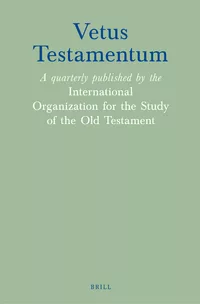https://doi.org/10.1163/15685330-bja10166
이 논문은 히브리어 예레미야서(MT-Jer)에 등장하는 שֶׁקֶר(거짓)의 사용과, 이를 칠십인역(LXX)과 페쉬타(P)가 어떻게 해석·번역했는지를 비교한다. 이를 통해 LXX와 P에서의 거짓·허위(ψευδής, ψεῦδος, ἄδικος, μάτη, ܫܘܩܪܐ, ܕܓܠܘܬܐ) 및 거짓 예언자(ψευδοπροφήτης, ܢܒܝܐ ܕܓܠܐ) 개념을 분석하며, 특히 P-Jer의 거짓 예언자 이해를 본격적으로 다룬 첫 연구로서 의의를 갖는다.
연구 결과, LXX와 P 모두 원문을 엄밀히 직역하기보다 목표 언어의 의미망에 맞춰 해석했으며, 히브리어 שֶׁקֶר의 다의성(polysemy)을 드러냈다. 두 번역본 모두 일정 수준의 문학적 자유와 해석적 변형을 보여주며, 특히 P는 하나냐(Hananiah)를 P-Jer 28 전반에서 체계적으로 거짓 예언자로 지칭한 반면, LXX는 LXX-Jer 35:1에서 단 한 번만 그렇게 부른다. 이러한 차이는 P가 LXX의 직접적 영향을 받지 않았다는 주장에 힘을 보탠다.
This article explores the use of שֶׁקֶר in MT-Jer, and the manner in which the Septuagint (LXX) and Peshitta (P) read it. In that regard, the article also discusses lying, falsehoods (ψευδής, ψεῦδος, ἄδικος, µάτη, ܫܘܩܪܐ, ܕܓܠܘܬܐ), and false prophets (ψευδοπροφήτης, ܢܒܝܐ ܕܓܠܐ) in LXX and P. As such, it pioneers the examination of P-Jer’s perspective on false prophets. The article demonstrates that the translators of LXX and P approached the Hebrew source text in a manner that was not strictly literal, aligning with the nuances of the target language. It is argued that both LXX-Jer and P-Jer illuminate the polysemy inherent in the Hebrew lexeme שֶׁקֶר. In addition, both versions demonstrate a degree of textual liberty and interpretative renderings. Finally, the article demonstrates that unlike LXX, which labels Hananiah as a false prophet only once (LXX-Jer 35:1), P systematically designates him so throughout P-Jer 28. Consequently, the article also adds weight to the argument opposing a direct textual influence of LXX on P.






